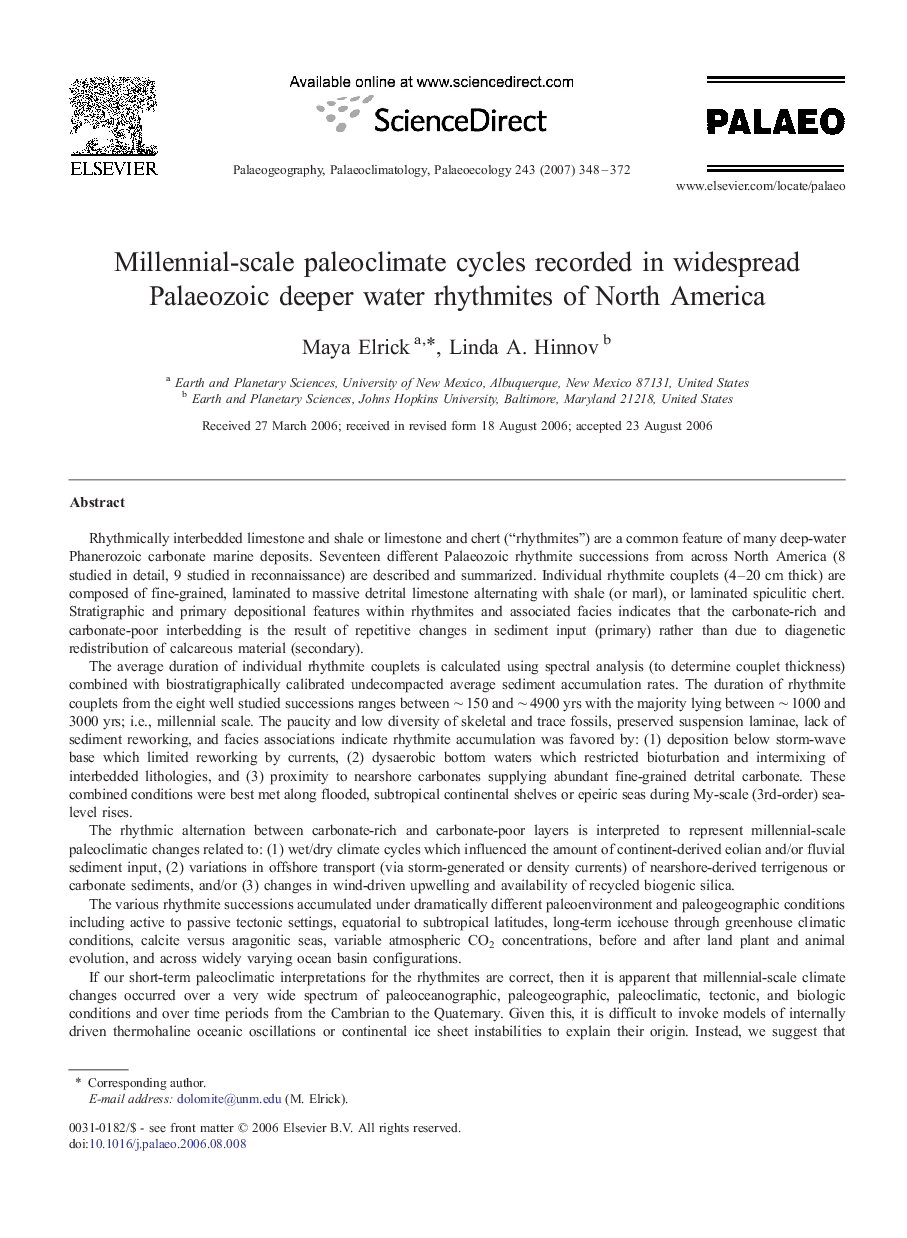| کد مقاله | کد نشریه | سال انتشار | مقاله انگلیسی | نسخه تمام متن |
|---|---|---|---|---|
| 4469138 | 1622360 | 2007 | 25 صفحه PDF | دانلود رایگان |

Rhythmically interbedded limestone and shale or limestone and chert (“rhythmites”) are a common feature of many deep-water Phanerozoic carbonate marine deposits. Seventeen different Palaeozoic rhythmite successions from across North America (8 studied in detail, 9 studied in reconnaissance) are described and summarized. Individual rhythmite couplets (4–20 cm thick) are composed of fine-grained, laminated to massive detrital limestone alternating with shale (or marl), or laminated spiculitic chert. Stratigraphic and primary depositional features within rhythmites and associated facies indicates that the carbonate-rich and carbonate-poor interbedding is the result of repetitive changes in sediment input (primary) rather than due to diagenetic redistribution of calcareous material (secondary).The average duration of individual rhythmite couplets is calculated using spectral analysis (to determine couplet thickness) combined with biostratigraphically calibrated undecompacted average sediment accumulation rates. The duration of rhythmite couplets from the eight well studied successions ranges between ∼ 150 and ∼ 4900 yrs with the majority lying between ∼ 1000 and 3000 yrs; i.e., millennial scale. The paucity and low diversity of skeletal and trace fossils, preserved suspension laminae, lack of sediment reworking, and facies associations indicate rhythmite accumulation was favored by: (1) deposition below storm-wave base which limited reworking by currents, (2) dysaerobic bottom waters which restricted bioturbation and intermixing of interbedded lithologies, and (3) proximity to nearshore carbonates supplying abundant fine-grained detrital carbonate. These combined conditions were best met along flooded, subtropical continental shelves or epeiric seas during My-scale (3rd-order) sea-level rises.The rhythmic alternation between carbonate-rich and carbonate-poor layers is interpreted to represent millennial-scale paleoclimatic changes related to: (1) wet/dry climate cycles which influenced the amount of continent-derived eolian and/or fluvial sediment input, (2) variations in offshore transport (via storm-generated or density currents) of nearshore-derived terrigenous or carbonate sediments, and/or (3) changes in wind-driven upwelling and availability of recycled biogenic silica.The various rhythmite successions accumulated under dramatically different paleoenvironment and paleogeographic conditions including active to passive tectonic settings, equatorial to subtropical latitudes, long-term icehouse through greenhouse climatic conditions, calcite versus aragonitic seas, variable atmospheric CO2 concentrations, before and after land plant and animal evolution, and across widely varying ocean basin configurations.If our short-term paleoclimatic interpretations for the rhythmites are correct, then it is apparent that millennial-scale climate changes occurred over a very wide spectrum of paleoceanographic, paleogeographic, paleoclimatic, tectonic, and biologic conditions and over time periods from the Cambrian to the Quaternary. Given this, it is difficult to invoke models of internally driven thermohaline oceanic oscillations or continental ice sheet instabilities to explain their origin. Instead, we suggest that millennial-scale paleoclimate variability is a more permanent feature of the Earth's ocean–atmosphere system, which points to an external driver such as solar forcing.
Journal: Palaeogeography, Palaeoclimatology, Palaeoecology - Volume 243, Issues 3–4, 22 January 2007, Pages 348–372